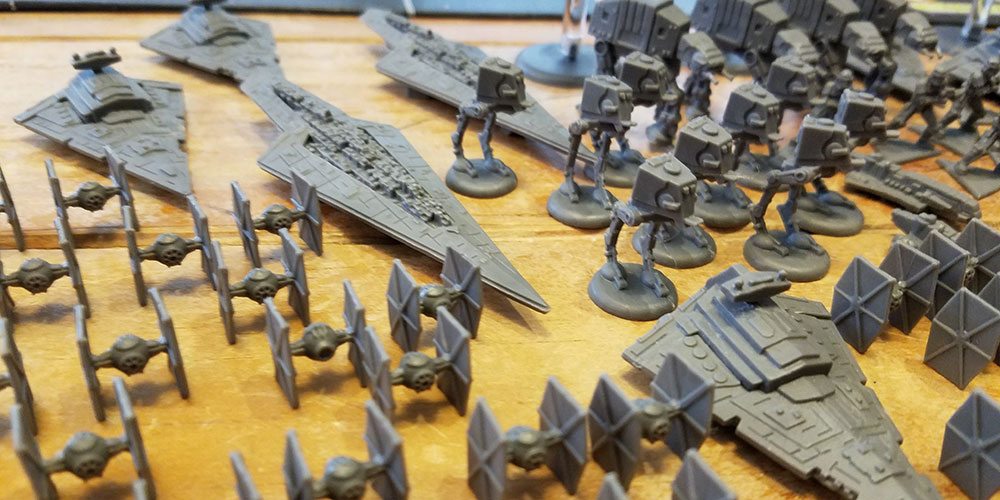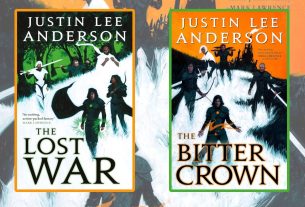
Ever since they got the license to produce games in a galaxy far, far away, Fantasy Flight has allowed us to pretend we’re Wedge Antilles dog fighting with Boba Fett with the X-Wing Miniatures Game, or play Han and Chewie trying to infiltrate an Imperial bunker in Imperial Assault, or even let us take command on a Star Destroyer and pound the Rebel fleet into submission in Armada. And while all three of these titles are truly great, they are all also quite complex. It can take hours to explain just what all of those cardboard tokens mean in X-Wing or Armada, and regular readers of this blog have perhaps seen my friend Anthony Karcz’s series of posts on the time it takes to paint the miniatures in Imperial Assault before you even sit down to play. And also, while all of them let you relive classic moments in the Star Wars universe, none give you the whole breadth and scope of the galactic conflict between the Empire and the Rebels.
But late last year, Fantasy Flight finally filled this void with the release of Star Wars: Rebellion.
At a glance: Rebellion is a board game for 2-4 players. The game basically follows the concept of the original trilogy–the Empire is trying to find and destroy the Rebel base before the Rebels can turn enough systems against the Empire to bring it down. The game retails for $100, but can often be found cheaper online. As of this writing, Amazon is selling it for $75.

Components:
153 plastic miniatures*
1 game board, in 2 pieces
15 Objective cards
25 Leaders with plastic stands
3 Destroyed System markers
2 Faction sheets
68 Mission cards
27 Subjugation/Imperial Loyalty markers
12 Rebel Loyalty markers
32 Damage markers
1 Time marker
1 Reputation marker
31 Probe cards
7 Attachment rings
10 Sabotage markers
10 Custom dice
30 Tactic cards
34 Action cards
Like other FFG games, the components in Rebellion are seriously cool. The miniatures are unpainted, but unlike Imperial Assault they have distinctly different colors and the game is designed to be played with them out-of-the-box. And besides, in addition to the standard things you’d expect like X-Wings and TIE Fighters and AT-ATs, Rebellion comes with Super Stay Destroyers and three–yes, three–Death Stars (2 complete, 1 unfinished).

One more thing: while you can see from the list above that there are five separate decks of cards and a lot of tokens (it is, after all, a game from Fantasy Flight), I don’t feel like they bog down the game the way they do in X-Wing or Assault.
Gameplay:
In a two player game, each person picks a side. The Rebels are badly outnumbered but have more objectives and things to do, while the Imperials have a massive war machine backing them. Also, as the Imperial player, you have the possibility of getting to use a Death Star to destroy a system. So there’s that. In a three player game, one person plays one side while the other two team up on the other side, and in a four player game, you have two teams.

Each player (or players) gathers up all of the components for their side: their set of minis and their leaders, loyalty markers, faction sheet, and mission and action cards. Then, the Rebels take Mon Mothma, Princess Leia, General Rieekan and Jan Dodonna as their starting leaders and place them on their Faction Sheet. The Imperial player does the same with Darth Vader, the Emperor, General Tagge and Grand Moff Tarkin. The Time marker is placed at the “1” spot on the time track on the board, and the Rebel Reputation marker is placed at space “14”. Each turn sees these move closer to each other; to win, the Rebel needs to get these to the same space on the board, while the Imperial needs to find and destroy the Rebel base before that happens.

The Objective deck is then sorted and placed on its spot on the board. Each player shuffles their Action deck and places it next to their Faction Sheet. The various Mission decks are sorted and placed either on the board or with each player. Then, players place their starting forces on the board, either using a prescribed setup from the rule book (for the first few games) or however they choose (for later games once you know what you’re doing). The Rebel player then takes the Probe deck, which is made up of cards showing each of the systems on the board, removes any cards that match the locations where the Imperial player put forces, and secret chooses one as the location of their base. They take this card and place is off the side of the board, then they shuffle all of the remaining Probe cards and place it on its spot on the board. Finally, each player draws four cards from their Mission deck.

Each turn is made up of three phases.
In the Assignment phase, the Rebel player assigns any leaders they have to missions by taking a Mission Card from their hand, placing it face-down in front of them, and placing either one or two leaders on it. Then, the Imperial player does the same.
In the Command phase, players deploy their leaders and units. Starting with the Rebels, each player takes turns either placing a leader from their pool (so, one they didn’t assign to a mission) in a system to activate it, or they reveal and complete a mission.

Activating systems is the primary way that players move their forces around the board. When a leader is placed in a system, any ships in adjacent systems can be moved into the activated system, based on the ships movement values. Some of these ships can also pick up and transport ground forces. If this results in forces ending up in a system that contains opposing forces, combat ensues.
Combat in Rebellion finds that balance between being simple enough to be quick and enjoyable, while complex enough to not rely purely on lucky dice rolls. When fighting, each player needs a leader. The player who is taking the turn will already have a leader in the system, as they could not have moved forces into place without one. But now the opposing leader gets to take a leader from their pool and add it to the system. Then, each player draws tactic cards, based on their leader. These cards provide bonus values when the fighting starts.

Combat is then divided into multiple rounds. In each round, players first resolve space battles, then ground combat. Then, either player can retreat or, if both still have forces left in the system, you repeat.
Each type of ship has a series of combat values for attacking, based on what they’re shooting at, and defending. Players roll die based on these values. They can then play tactic cards, which may do things like add extra hits. Damage, which is simply hit/no hit, is assigned to units. One more round of tactic cards, if the player has any that prevent damage. Then, any ships that took more damage than their health value are removed, and combat continues until one player either retreats or is destroyed.

If the player reveals a mission, they move the leader or leaders assigned to that mission to the system indicated on the card. Then, the opponent can choose to try to oppose the mission by moving one of their leaders to the same system. All missions have certain required skills, and the leaders on both sides need to match these skills in order to either complete or oppose the mission. Then, each player rolls dice and counts up successes. The one with the most successes wins. If the player who revealed the mission wins, they perform whatever actions are indicated on the card. If the opposing player wins, nothing happens, meaning that their opponent does not get to do whatever the card said.

The majority of the strategy in the game revolves around careful deployment of the leaders. You want to make sure you have the right leaders to accomplish missions, but at the same time you need to hold some back to either oppose your opponent’s missions or be ready to send a leader into combat. In the times we’ve played, nothing leads to quicker defeat than mismanagement of leaders.
After both players are done revealing missions or activating systems, there is a refresh phase where leaders are removed from the board and placed back on the Faction Sheet, new missions are drawn, and the time and (possibly) reputation markers are moved. The Imperial player also draws two probe cards. As the Rebel base was removed from the deck, this tells the player two systems where they now know the base isn’t. They keep this information from the Rebel player.
Players get to build new units based on the Time marker. If they have any that are ready (it can take several turns to build bigger things), they deploy them either to their base or to loyal systems. They may also be able to recruit new leaders, who are then added to their leader pool.
The game ends with a win for the bad guys when either the Imperials find the Rebel based, either through deduction or blind luck, and destroy any forces there, or a win for the good guys when the Rebel reputation marker, which is moving down the time track as the Rebels succeed in missions, ends up on the same space as the Time marker.

Oh, and remember the Death Star? In order to use it, the Imperial player has to draw a special mission card. This can either be cool if they’re lucky and get it early, or possibly quite frustrating. The Imperial player simply plays this card as one of their missions and wipes out a system. Any Rebel forces there are immediately destroyed, and if it turns out to be the Rebel base, the Imperial player immediately wins.

The Rebels, for their part, have a “Death Star Plans” card in their Objectives deck. They can destroy the Death Star by first destroying any other forces in the same system as the base, then playing this card. They then roll 3 dice, and if they get a hit, the Death Star is destroyed. This isn’t an instant win for them, but it does give them 2 reputation. However, the Imperial player may be able to rebuild…and in fact, if they play things just right, they may even have more than one space station on the board at once.
The Verdict:
Honestly, I was a bit surprised at just how much fun Rebellion was the first time I played it. Just opening the box made me a bit giddy, since all of those miniatures are just so cool, but the game play didn’t disappoint either. I think I might have been a bit jaded from the other Fantasy Flight titles and their complexity. While my son enjoys playing X-Wing with me, I haven’t yet gotten him in to Assault or Armada because he gets bored with rules explanations that go on and on, and doesn’t have a lot of interest in tracking a bunch of text on a bunch of cards or worrying about a hundred different tokens on the board. And so Rebellions‘ vastly simplified system works out great. And I think that we both enjoy the bigger scope of the game, because while defeating star ships in one-on-one combat is fun, deciding the fate of the entire galaxy is even more fun.
The Future:
One last note. Fantasy Flight recently announced Rise of the Rebellion, the first expansion to Rebellion, due out this fall, which will add the characters and planets from Rogue One to the game. I can’t wait.



